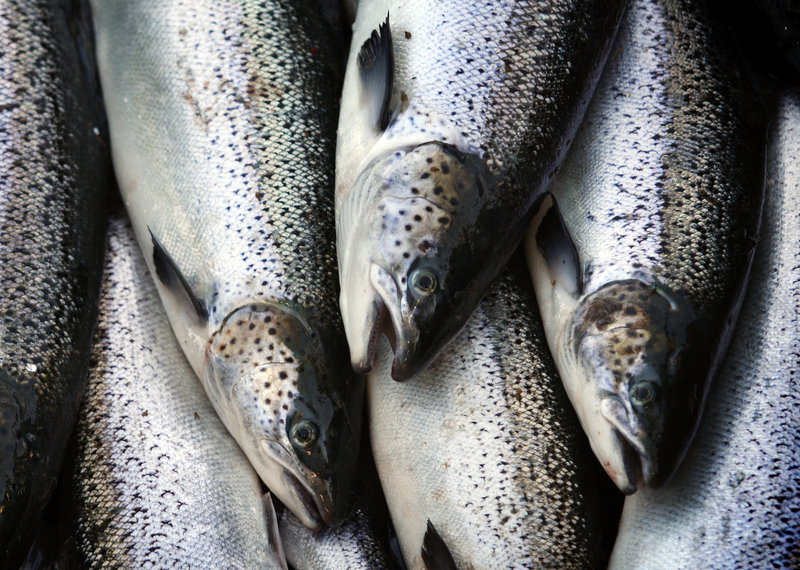WASHINGTON – With a global population pressing against food supplies and vast areas of the ocean swept clean of fish, tiny AquaBounty Technologies Inc. of Waltham, Mass., says it can help feed the world.
The firm has developed genetically engineered salmon that reach market weight in half the usual time. What’s more, it hopes to avoid the pollution, disease and other problems associated with saltwater fish farms by having its salmon raised in inland facilities.
The Food and Drug Administration has yet to approve what would be the nation’s first commercial genetically modified food animal.
“This is the threshold case. If it’s approved, there will be others,” said Eric Hallerman, head of the fisheries and wildlife sciences department at Virginia Tech University.
“If it’s not, it’ll have a chilling effect for years.”
Some in the fish farming industry are leery of the move toward engineered fish.
“No! It is not even up for discussion,” Jorgen Christiansen, director of communications for Oslo-based Marine Harvest, one of the world’s largest salmon producers, wrote in an e-mail.
Christiansen said his company worries “that consumers would be reluctant to buy genetically modified fish, regardless of good food quality and food safety.”
Some critics call AquaBounty’s salmon “Frankenfish.” Others say the effort is pointless.
“I don’t see the necessity of it,” said Casson Trenor of Greenpeace USA — which opposes all genetically modified organisms, including plants. “We don’t need to build a new fish.”
The FDA has completed its review of key portions of AquaBounty’s application, according to Chief Executive Ronald Stotish.
Within weeks, the company expects the agency to convene an advisory committee of outside experts to weigh evidence, collect public testimony and issue a recommendation about the fish’s fitness for human consumption.
The process could take months or more — which still sounds like progress to the company after its 14-year, $50 million investment.
Manipulating natural processes is a fact of life in most of the world’s food supplies. Cattle, hogs, poultry and most grain and vegetable crops have been extensively altered through selective breeding and hybridization — including turkeys with so much white meat they can barely stand, drought- and disease-resistant wheat, and fruits and vegetables that resist bruising or spoiling.
But genetic engineering — especially perhaps of animals — is different, at least in the public mind.
“The thought of genetic engineering sort of excites the idea that there might be a kind of boundary-crossing going on that might be yucky,” said Paul Thompson, an agricultural ethicist at Michigan State University.
Unlike ordinary salmon, AquaBounty’s genetically modified fish grows during the winter as well as the summer, so it reaches an 8-pound market weight in 18 months instead of 36. That’s accomplished by inserting part of a gene from an eel-like creature called the ocean pout into the growth gene of a Chinook salmon, then injecting the blended genetic material into the fertilized eggs of a North Atlantic salmon.
“This is a single gene and it’s a salmon gene in a salmon,” said Stotish, a biochemist and pharmaceutical researcher who joined AquaBounty in 2006 and became CEO two years later.
The salmon is identical in taste, color, protein and other attributes of a non-engineered North Atlantic salmon, he said, and consumes up to 25 percent less food over its lifetime. The AquaBounty salmon don’t get bigger than other salmon; they just grow to full size faster.
Christiansen isn’t the only person in the industry to recoil.
“We do not support it. … We wouldn’t consider changing that unless the market demanded it and all government regulators say it’s safe,” said Nell Halse, president of the International Salmon Farmers Assn.
On the other hand, the National Fisheries Institute, the main trade association of U.S. seafood producers, supports “the use of biotechnology in the production of genetically engineered fish,” subject to FDA safety assessments, spokesman Gavin Gibbons said.
AquaBounty, which would sell genetically altered eggs, says its fish would be sterile and it intends to require producers to raise its salmon inland.
The idea is to prevent cross-breeding with wild fish. Most farmed salmon are kept in ocean pens, where wild and confined fish can infect each other with disease — and where escapees can join the gene pool, producing offspring less suited to the open ocean.
If AquaBounty’s fish are raised in inland tanks, wild populations should be protected.
Send questions/comments to the editors.



Comments are no longer available on this story